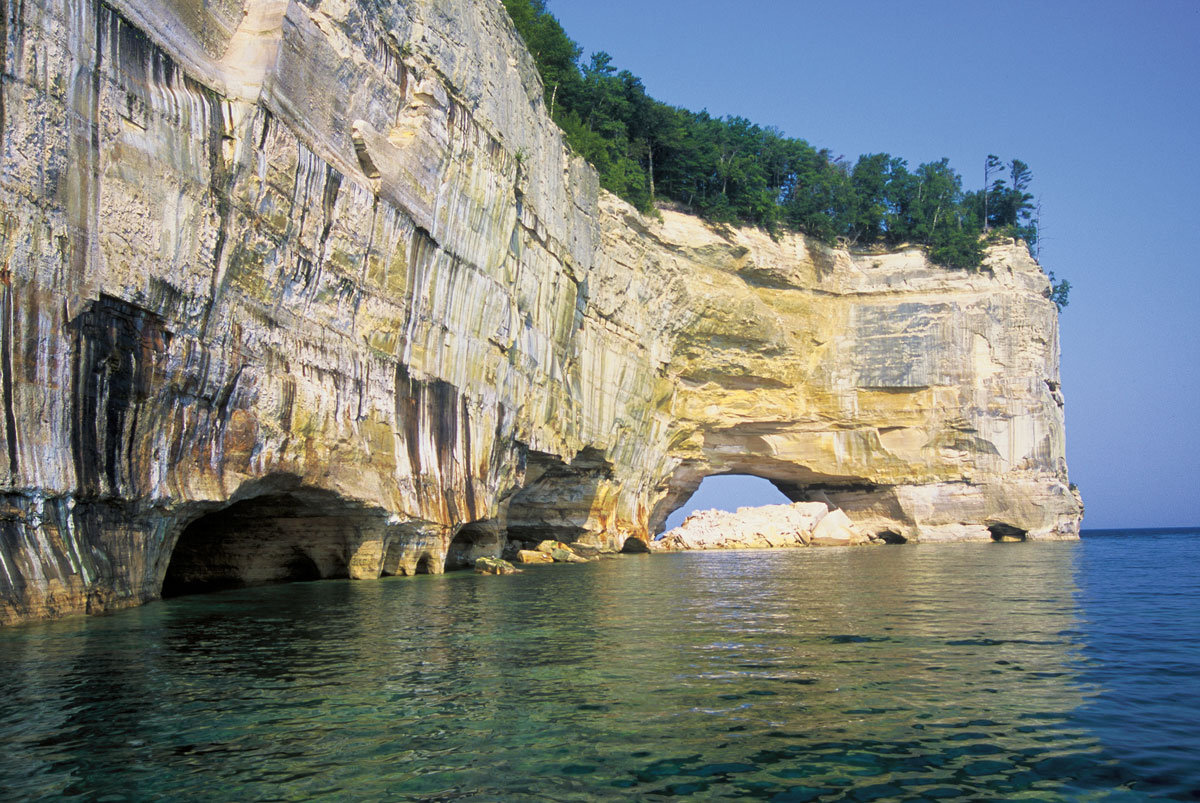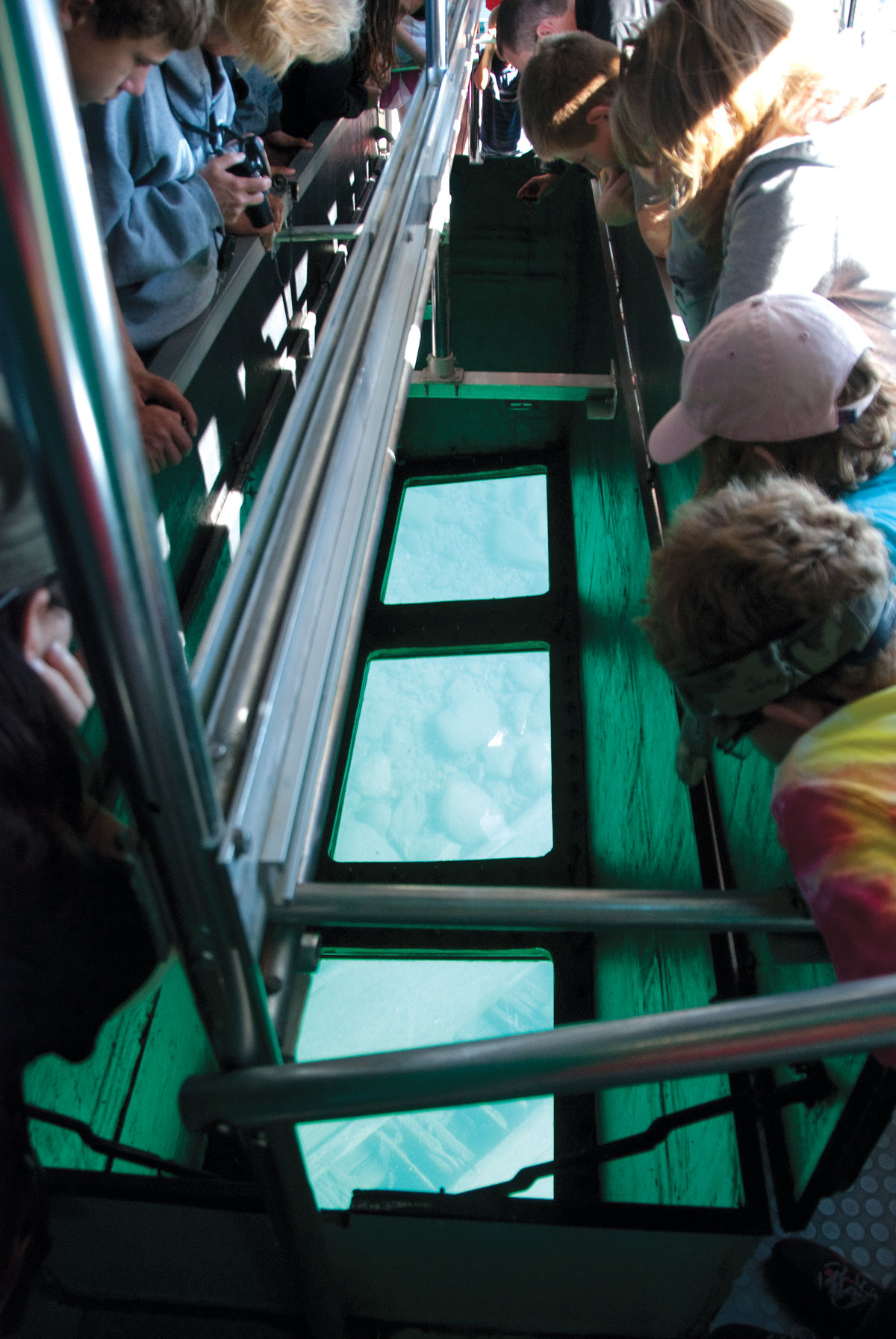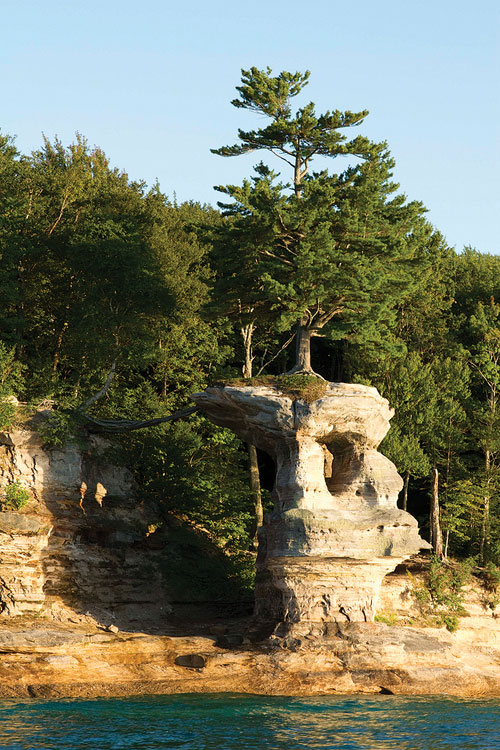Photo by Andrew Horn
Whether you choose to explore from the water or via land, Lake Superior’s Pictured Rocks, the country’s first National Lakeshore, remains a stunning Great Lakes treasure.
They soar from 50 to 200 feet above the pristine south shore of Lake Superior, gleaming with subtle hues of cream, apricot, champagne, gold and taupe. They’re streaked from mineral-laden groundwater seeps, and caves, arches and hoodoo-like rock outcroppings decorate their strong arms and broad faces. In the spring and early summer, they’re adorned with silvery rivulets of cold water, seasonal waterfalls that plummet to the vast Big Lake below.
They’re achingly old, these Cambrian sandstone cliffs. They are part of the 500-million-year-old Munising Formation, which stretches from Munising and Laughing Whitefish Falls in the west to Grand Marais and Tahquamenon Falls, celebrated in Henry Wadsworth Longfellow’s epic 1855 poem “The Song of Hiawatha,” in the east.
And they’re the namesake attraction of Pictured Rocks National Lakeshore, which stretches across approximately 73,000 acres of thickly forested Upper Michigan landscape and 42 miles of wild shoreline. Named for those 15 miles of multicolored sandstone walls, Pictured Rocks became the United States’ first national lakeshore in 1966.
Start your Pictured Rocks visit either at the Grand Sable Visitor Center in Grand Marais, or at the Interagency Visitors Center, Munising Falls Interpretive Center and Miners Castle Information Station, all in Munising. From there, you can drive on paved roads into the national lakeshore; however, only County Road H-58 traverses the entire park.
While the roads allow you to see the Lake Superior shore near Grand Sable Dunes (where the tallest dunes rear 275 feet above the lake), Twelvemile Beach and Miners Castle, hiking is the best way to see the majority of the Pictured Rocks coast. The park features 90 miles of trails, including a 42-mile stretch of the famous North Country National Scenic Trail, which runs from North Dakota to New York.
Approximately 8 miles of the North Country trail pass through the Beaver Basin Wilderness, which comprises 11,740 acres within the national lakeshore. It was created in March 2009, when President Obama signed the Omnibus Public Land Management Act. The 3.5-mile-deep wilderness area includes 13 miles of shoreline from Spray Falls in the west to Sevenmile Creek in the east, and it incorporates 8.5 miles of connector trails and six backcountry campsites.
Remember that pets are only permitted on select trails within the park, and bicycles are allowed on roads only. And, if you wish to experience backcountry camping, you’ll need a permit from one of the visitor’s centers. Please practice Leave No Trace by packing out all trash and burying any waste 4 to 6 inches deep.

Photo courtesy of National Parks Service
Bottoms-Up
 When most of us think of glass-bottom boat tours, we think of places like the Florida Keys and the British Virgin Islands. We imagine such lower-latitude attractions as coral reefs, sharks and colorful schools of tropical fish, and we dismiss the idea that the Great Lakes have anything special to offer beneath the waves.
When most of us think of glass-bottom boat tours, we think of places like the Florida Keys and the British Virgin Islands. We imagine such lower-latitude attractions as coral reefs, sharks and colorful schools of tropical fish, and we dismiss the idea that the Great Lakes have anything special to offer beneath the waves.
We’re so wrong.
All five Great Lakes are home to a staggering number of shipwrecks, and Lake Superior boasts some of the best-preserved specimens, thanks to its icy, fresh water and lack of zebra mussel encrustation. The south shore, home to Pictured Rocks National Lakeshore, has its own admirable collection. In the depths of Munising Bay, which is now part of Michigan’s Alger Underwater Preserve, lie the 1890 “lumber hooker” Herman H. Hettler; the 1860 schooner Bermuda; the three-masted wooden steamer Smith Moore, which sank in 1889; the 1920 freighter Kiowa; the 1887 steamer Manhattan; the 1867 steam barge Michael Groh; a mysterious, undated scow schooner; and the steel tug Steven M. Selvick, which was intentionally sunk in 1996 for the preserve.
Unfortunately, the wrecks were limited to certified scuba divers — until Captain Pete Lindquist had an idea. He decided to start offering tours out of nearby Munising, equipping his vessels with viewing bays so non-diving guests could experience some of the wrecks and enjoy unparalleled underwater views.
From May 25 to October 12, Lindquist’s Munising Bay Shipwreck Tours offers two-hour, fully narrated cruises that include three wrecks (the Hettler, Groh and Bermuda), the venerable 1869 Grand Island East Channel Lighthouse, and the area’s striking rock cliffs, caves and waterfalls. Other attractions include Grand Island’s North Light, the Williams Hotel and the Original Settlement. Guests might even spot deer, bald eagles and black bears.
The 60-foot Miss Munising can carry 70 guests, while the 55-foot Fireball carries approximately 50.
To learn more, call 906-387-4477 or visit shipwrecktours.com. http://www.shipwrecktours.com
Photo by Mark Bauhs
Photo by Mark Bauhs
Paddling paradise
Pictured Rocks National Lakeshore is perhaps even better known among hardcore paddlers than it is among hikers and backpackers. The soaring cliffs, memorable rock formations, ethereal waterfalls, stretches of white-sand beach, blue-green summer lake — this is a sea-kayaking paradise.
Paddlers can launch at the Grand Marais harbor beach or in Munising, at Grand Island Landing, the City of Munising’s Brown’s Addition boat ramp or the Anna River. Within the park itself, you can splash your boat at Hurricane River, Twelvemile Beach, Miners Beach and Sand Point.
And once you get offshore, you’ll be on the Hiawatha Water Trail, which runs 120 miles from Big Bay to Grand Marais and follows a route once well-traveled by native people, voyageurs, fur traders and explorers. You’ll certainly share the sentiments of Henry Rowe Schoolcraft, the noted wilderness scholar and ethnologist, who in 1820 said Pictured Rocks boasted “some of the most sublime and commanding views of nature,” noting that “we were wholly unprepared to encounter the surprising groups of overhanging precipices, towering walls, caverns, waterfalls… mingled in the most wonderful disorder.”
Just keep in mind that the Pictured Rocks themselves are exposed, sheer sandstone cliffs that offer zero protection if the weather heads south. And on unpredictable Lake Superior, paddlers may face plunging temperatures, high winds, rough seas, fog and bitterly cold water, even in midsummer. Only experienced paddlers with the correct equipment should attempt to explore the coastline by kayak or canoe, and checking the NOAA marine forecast before departure is a must.
The same goes for boaters in their own cruisers or trailerable boats. If you’re leaving the dock or launching from the Burt Township Marina in Grand Marais, Munising’s municipal marina, or Brown’s Addition boat ramp, double-check marine forecasts and keep a weather eye on the big lake they call Gitche Gumee. It’s worth noting local native communities would try to ensure safe passage along these shores through sacred tobacco offerings.
Lovely lakes
If you’re feeling slightly less adventurous but would still like to enjoy Pictured Rocks National Lakeshore from the water, it’s worth checking out the park’s inland lakes for boating and fishing. You can operate motorized vessels and even waterski on Grand Sable Lake, although the horsepower limit is 50; if your boat has an electric motor, you also can launch at Little Beaver Lake and Beaver Lake.
Personal watercraft are not allowed on the inland lakes. You may use them between Sand Point and Miners Beach on Lake Superior, but they’re not allowed anywhere else within one-quarter mile of the park’s shoreline. Sand Point has a shallow ramp for launching.
Canoeists and kayakers have access to Beaver, Little Beaver and Grand Sable lakes, and if they’re willing to carry their boats, they can paddle Legion, Miners and Chapel lakes as well. Again, if you’re planning on spending the night in the backcountry, please obtain a permit at one of the visitor’s centers prior to your outing.

Photo by Scott Calleja
More to explore
If you’d prefer to experience Pictured Rocks waters without putting on your captain’s hat, simply join a boat tour, a dive charter or a guided kayak expedition. Knowledgeable guides will tell you all about distinctive rock formations like Indian Head, Chapel Rock and Miners Castle, which lost a turret in a 2006 rock fall.
You won’t want to miss the waterfalls, which include little Mosquito Falls, where the river otters play; 50-foot Miners Falls, along the Miners Falls Nature Trail; 60-foot Chapel Falls, near Chapel Lake; 75-foot Sable Falls; seasonal Bridal Veil Falls, just northeast of Miners Beach; and 70-foot Spray Falls, at the base of which lies the wreck of the 191-foot sidewheel steamer Superior. She sank in heavy seas in 1856, and between 35 and 42 people lost their lives. She now lies in 10 to 30 feet of water.
Despite the magic of Pictured Rocks, the national lakeshore receives less than half a million visitors per year. That’s good news, as it means uncrowded trails, peaceful campsites and plenty of room on the lakes, big and small. The search for solitude will be an easy one.
That’s especially true during the winter months, when the Lake Superior snow belt turns the park white with an average of 140 inches of snow.
From late November to mid-April, this is a veritable winter wonderland. If you’re a serious outdoor adventurer, this is the time for winter camping and ice climbing. If you’re looking for some family-friendly daytime outings, pack the cross-country skis and snowshoes, enjoy the park for a few hours, and then head into Munising or Grand Marais for a hot meal and perhaps a toddy or two. You can even bring your snowmobiles, as sleds are allowed in designated areas.
There’s no doubt Pictured Rocks National Lakeshore is a Great Lakes treasure, a place where real wilderness survives and thrives in all its soaring, tumbling, majestic glory. A place to feel free, “chasing dreams and racing fathered time.”
Those lyrics are from Kid Rock’s “Born Free.” If you look up the video on YouTube, you’ll find that the Michigan-born rocker chose to film it in a very special place. Pictured Rocks.
Plan Your Trip

When To Go
Peak season in Upper Michigan is mid-June through late August, with July and August offering the warmest air and water temperatures.
Climate
Packing for a summer trip to the upper Great Lakes is more of an art than a science. If you don’t like the weather, as an old saying goes, wait 5 minutes; it’ll change. Generally, U.P. summers mean pleasant, warm days and comfortable evenings. Make sure to plan for the inevitable weather whiplash, however, which might include hot, humid days or chilly, damp ones.
Essential Gear
Pictured Rocks National Lakeshore is home to some serious outdoor recreation during the summer months. So, don’t forget your:
Hiking boots: There are more than 90 miles of trails in the national lakeshore. Lace up those boots and get out there!
Bicycle: Find peace on quiet, lightly traveled roads.
Camping gear: Plan an overnight expedition and get a taste for the backcountry.
Binoculars: Keep an eye out for the national lakeshore’s resident flora and fauna.
Kayak: Paddle the inland lakes or, if you’re more experienced, explore the Lake Superior shoreline.
Fishing gear: Try your hand on the little inland lakes… or on the Big One.
Scuba tanks: Descend into the Alger Underwater Preserve!
Picnic and cold beverages: Hang out on the pristine white-sand beaches at Twelvemile, Miners and Sand Point.
And, again, winter isn’t off the table. Cloaked in white, dotted with year-round campsites and criss-crossed with snowshoeing and cross-country skiing trails, Pictured Rocks National Lakeshore will be a memorable offseason destination for those who love the great outdoors.
Photo courtesy of National Parks Service


